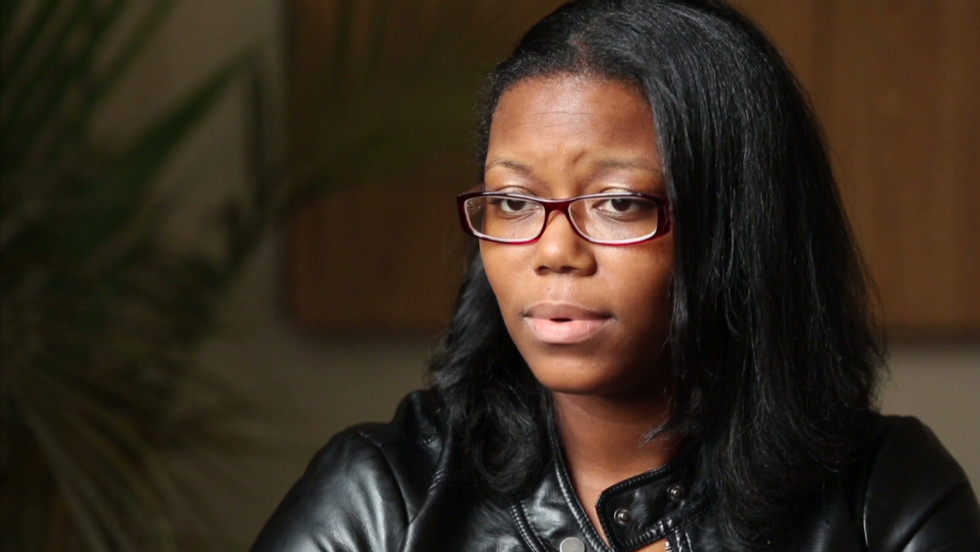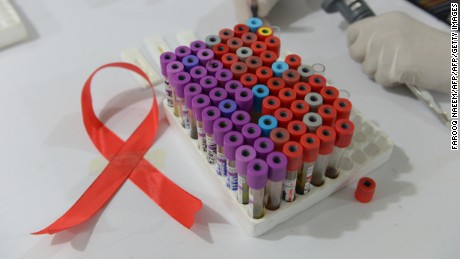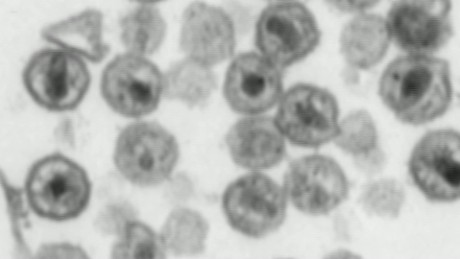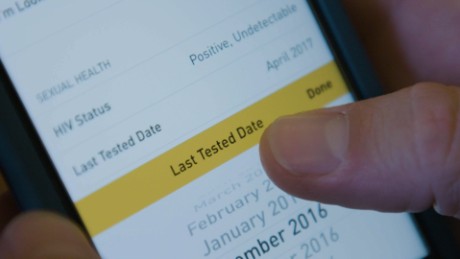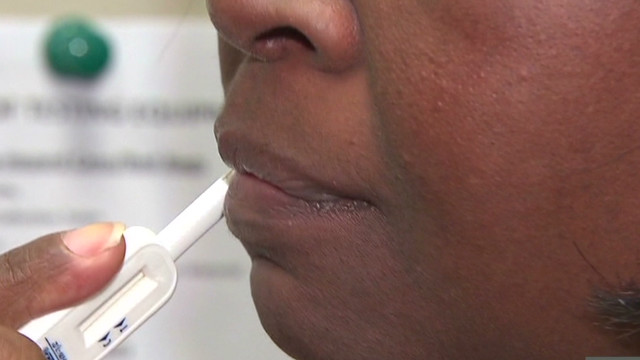Story highlights
- Americans 15 to 44 think they're "unlikely to have been exposed to HIV"
- Young people, 15 to 24, were more likely to have never been tested
(CNN)Young people seem to be less likely to get tested for HIV than older adults, and a new study now reveals the reasons why.
In the United States, 38.8% of women and 53.8% of men aged 15 to 44 reported they had never been tested for HIV outside of donating blood or blood products between 2011 and 2015, according to a new study published in the Centers for Disease Control and Prevention's National Health Statistics Reports on Thursday (PDF).
Yet among those 15 to 24, the percentage who reported they had never been tested soared to 63.9% of women and 73.7% of men.
The most common reason reported by women and men for having never been tested was that they thought they were "unlikely to have been exposed to HIV," according to the study.
"It was very interesting to see that the percentages of never been tested was significantly lower for women compared with men. And, never been tested for HIV was lower among those who had any HIV risk-related sexual or drug behaviors in the past year compared with those who did not report these behaviors," said Isaedmarie Febo-Vazquez, a researcher at the CDC and first author of the study.
"This report is adding more information and data in the area related to HIV testing," she added. "So overall, knowing why people do not get tested is very valuable and this report was able to provide that information."
A previous study, conducted by CDC researchers and published in the journal Pediatrics in 2016, found that the percentage of young adults aged 18 to 24 who reported they have never been tested for HIV remained steady among young men, and increased significantly among young women between 2011 and 2013.
Specifically, among all young women, a significant decrease in the prevalence of HIV testing was detected overall, from 42.4% ever being tested in 2011 to 39.5% in 2013, according to that previous study, which was based on data from the national Youth Risk Behavior Survey and Behavioral Risk Factor Surveillance System.
When the data were examined by race, the researchers found HIV testing prevalence dropped among young white women from 37.2% in 2011 to 33.9% in 2013, and among young black women from 68.9% in 2011 to 59.9% in 2013.
The researchers behind that previous study wrote in the study's abstract, "No increase in testing among young adult males and decreased testing among young adult black females is concerning given their higher risk of HIV infection."
About 1.1 million people in the US are living with HIV, including about 166,000 who are unaware of their status, according to the CDC. As it turns out, about 30% of new HIV infections are transmitted by people whose HIV remains undiagnosed.
About 100,000 people are living with HIV in the United Kingdom, according to the agency Public Health England. Globally, about 36.7 million people are living with HIV, based on data from 2016, according to the World Health Organization.
Who's likely to get tested, and who's not
The new CDC study involved data on HIV testing habits and reasons for not getting tested self-reported by 9,321 men and 11,300 women, ages 15 to 44. The data were collected through in-person interviews between September 2011 and September 2015 as part of the National Survey of Family Growth.
The researchers found that about one in four women and one in three men who report behaviors that put them at risk for HIV actually had never been tested.
In other words, among women and men who reported any HIV risk-related behaviors, 27.8% of those women and 33.9% of those men said they were never tested for HIV.
HIV risk-related behaviors were described in the study as, in the past year, having five or more opposite-sex sexual partners; having male-to-male sex; having had sex in exchange for money or drugs; having had sex with an HIV-positive partner; having had sex with a partner who injects illicit drugs; using injectable illicit drugs, crack cocaine or meth; and for women, having sex with male partners who had sex with other males.
The researchers found that having never been tested was more common among younger Americans.
Among those age 25 to 34, 26.9% of women and 45.7% of men and, among those 35 to 44, 26.4% of women and 41.5% of men reported they had never been tested.
"Despite public health efforts to expand opportunities for HIV testing, in 2015, more than 50% of adults aged 18 to 64 in the United States had never been tested for HIV outside of the mandatory testing done for blood or blood product donation," the researchers wrote in the study.
The researchers also found that white women (at 42.6%), and men (57.1%), were more likely to report having never been tested for HIV compared with Hispanic women (36%), and men (56.4%), and black women (20.8%), and men (32.2%).
Women aged 22 to 44 with higher levels of education were more likely to report having never been tested, the researchers found. For instance, 36.5% of those with a bachelor's degree or higher compared with 23.6% of those with less than a high school education or GED reported having never been tested.
The researchers found the opposite pattern among men, with 45.7% of those with a bachelor's degree or higher compared with 70.2% of those with no high school diploma or GED reported having never been tested.
Reasons for not getting tested revealed
In general, 72% of women and 71.1% of men reported "unlikely to have been exposed to HIV" as the reason why they had never been tested, the researchers found, whereas 21% of women and 21.1% of men reported "never offered an HIV test" as the reason.
Among those who reported any HIV risk-related behavior in the past year, 58.8% of women and 62.7% of men reported "unlikely to be exposed to HIV" as their reason, whereas 26% of women and 27.8% of men reported "never offered an HIV test."
The study came with limitations, among them that the timing of when study participants engaged in HIV risk-related behaviors or underwent HIV testing was not determined.
The study participants did not include Americans who were homeless, incarcerated, or living on military bases at the time. The study also combined those who may have been tested for HIV as part of a blood donation with those who truly had never been tested at all into the "never tested for HIV" category, another limitation.
The new CDC study parallels a trend that experts have noticed happening for a while, said Rob Stephenson, a professor and director of the Center for Sexuality and Health Disparities at the University of Michigan in Ann Arbor, who was not involved in the study.
"If we look at the HIV incidence among risk groups in the US ... the greatest increase in incidence is actually among young men who have sex with men, in the 13 to 24 age group," Stephenson said.
"This paper confirms that this is the group among the least likely to test for HIV," he said. "So if you take the two in parallel, we know that HIV is increasing among the youngest age group and this paper confirms that we see less testing in this age group."
Separate CDC data show that American youth, ages 13 to 24, accounted for more than one in five new HIV diagnoses in 2015 -- and most of those new diagnoses, 81%, occurred among gay and bisexual men.
Stephenson was "incredibly" surprised to see HIV testing trends moving in this direction among American youth, he said, especially when there are many HIV testing options available to the public, from at-home HIV testing kits to community health events that involve HIV testing.
"HIV testing has too long been seen as an episodic event -- 'I get tested if I forgot to use a condom' -- for example. Why can't HIV testing be something that goes hand-in-hand with having our cholesterol checked every six months?" Stephenson asked.
"We don't want the pendulum to swing back to the 1980s where we scared everybody from HIV testing. Yet we also don't want the other extreme where it's seen as not a health threat," he said. "It needs to land somewhere in the middle, where it's seen as something you just do as part of your routine health check, and if you have certain risks then you should do it more often."
Dr. Gary Simon, a professor and director of the Division of Infectious Diseases at the George Washington University School of Medicine and Health Sciences, said that he often routinely screens his patients for HIV -- even if patients don't report at-risk behavior.
"Patients come into the clinic who I haven't seen before, and almost without exception, if they haven't had a HIV test, I tell them, I'm going to do a HIV test because I think you should have a HIV test," Simon said.
"It is a disease that can be relatively easily controlled," he added. "Over the years, I can't remember a patient who said 'no.'"
'If you've ever had sex, you should have an HIV test'
Dr. Andrea Ciaranello, associate professor of medicine and infectious disease specialist at Massachusetts General Hospital in Boston, noted that "it doesn't usually make sense" to test people only once in their lives for HIV.
"Patients may not perceive themselves to be at risk for HIV, and doctors may not know whether people are at low, average or high risk for HIV. It's important for people to realize that if you've ever had sex, you should have an HIV test," said Ciaranello, who was not involved in the new CDC study.
While some separate, previous studies have shown that HIV testing rates are flat or declining among young people, Ciaranello said that health care providers should start talking about and offering HIV testing and prevention to young patients.
Also, "parents should begin speaking with their kids about sex and drugs, including HIV and other sexually transmitted infections, early and often," Ciaranello said.
"My approach is generally to suggest making it mundane -- boring and factual, just like any other topic," she said. "And provide age-appropriate and biologically correct information as children begin to ask more questions."
